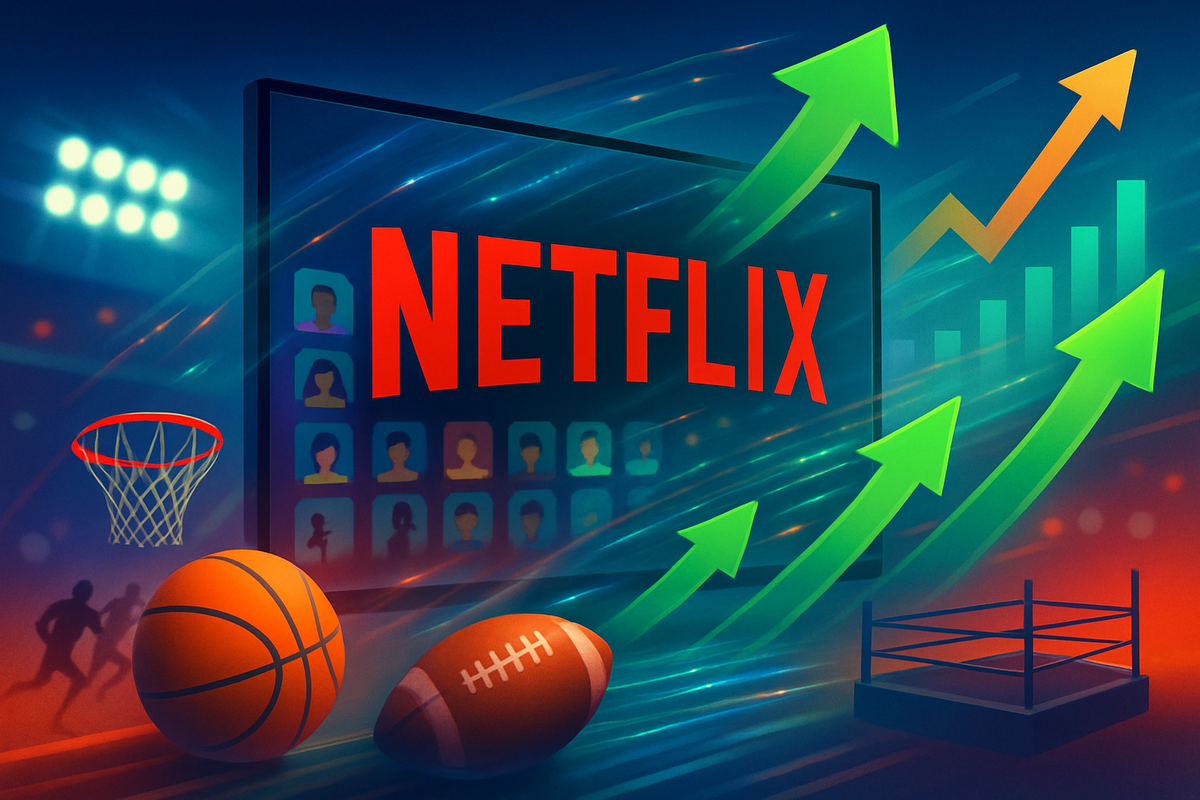Financial News
Netflix's $1,600 Horizon: Live Sports and Ad-Tier Drive Ambitious Growth

As of early October 2025, streaming giant Netflix (NASDAQ: NFLX) finds itself at a pivotal juncture, with its stock hovering around the $1,156-$1,162 mark. The company is actively pursuing an ambitious growth trajectory, aiming for a significant leap to a $1,600 stock valuation. This bold aspiration is underpinned by a multi-pronged strategy heavily reliant on an aggressive push into live sports content and the continued expansion of its ad-supported subscription tier, both of which are proving to be powerful engines for subscriber acquisition and revenue diversification.
The streaming landscape is fiercely competitive, and Netflix's strategic pivot reflects a clear understanding of evolving consumer demands and market dynamics. By integrating high-value, event-driven live sports into its content library, alongside a rapidly growing ad-supported offering, Netflix is not merely chasing subscriber numbers but also enhancing its Average Revenue Per User (ARPU) and establishing a more resilient business model. This strategic evolution is keenly watched by investors and industry analysts, many of whom see the potential for substantial upside if the company executes its vision effectively, with some even forecasting the $1,600 target within the next year.
The Playbook Unfolds: Netflix's Deep Dive into Live Events and Diversified Growth
Netflix's journey towards its ambitious valuation target is meticulously planned, with specific details revealing a calculated approach to market expansion. The company has made significant inroads into live sports, opting for high-impact, eventized programming rather than costly, full-season league rights, a strategy CEO Ted Sarandos has consistently championed. This approach aims to create "appointment viewing" that drives subscriber engagement and reduces churn without overextending content budgets.
Key moves in this strategic pivot include a landmark multi-billion dollar deal with World Wrestling Entertainment (WWE), which will see WWE's 'Raw' airing on Netflix starting in 2025. This follows successful forays into live National Football League (NFL) matches on Christmas Day in 2024, which delivered substantial viewership. Furthermore, Netflix has capitalized on the burgeoning popularity of influencer and professional boxing, hosting major bouts like the Jake Paul-Mike Tyson fight and the Canelo vs. Crawford match, which collectively garnered tens of millions of views globally. Looking ahead, the company has also secured rights for the FIFA Women's World Cup in 2027 and 2031, and is exploring other live events such as golf and tennis exhibitions, signaling a broad and sustained commitment to live content.
Beyond live sports, Netflix's subscriber growth strategies are robust and diversified. The company continues its substantial investment in original series and films, with a projected content budget of $18 billion in 2025, recognizing that premium original content remains a core driver of subscriptions. Critically, the ad-supported tier has emerged as a major growth engine, offering a more affordable entry point and attracting new users. This tier saw a 7% quarter-over-quarter growth in Q1 2025, accounting for over 40% of new subscriptions in available markets and boasting over 40 million monthly active users globally. Netflix anticipates doubling its advertising revenue in 2025, bolstered by the launch of its proprietary advertising technology platform. Additionally, initiatives to curb password sharing are expected to convert a significant number of freeloaders into paying subscribers, while continued international scaling with localized content remains a priority. Notably, since January 2025, Netflix has shifted its reporting metrics, focusing more on financial and engagement data rather than traditional subscriber numbers, reflecting the evolving nature of its business model.
Shifting Tides: Winners and Losers in the Streaming Arena
Netflix's (NASDAQ: NFLX) aggressive push into live sports and the expansion of its ad-supported tier are poised to create significant ripples across the media and entertainment industry, carving out clear winners and losers. The most obvious beneficiary is Netflix itself. By securing exclusive live sports content like WWE Raw and NFL Christmas games, Netflix gains a powerful tool for subscriber acquisition and retention, particularly among demographics traditionally drawn to linear television. These "appointment viewing" events reduce churn and provide premium inventory for its rapidly growing ad-supported tier, directly contributing to increased Average Revenue Per User (ARPU) and overall revenue growth, which are critical for reaching its $1,600 stock target. The diversification of its revenue streams, moving beyond pure subscription, also provides greater financial stability and resilience against market fluctuations.
However, Netflix's strategic moves pose substantial challenges for its competitors. Traditional broadcasters and cable providers, already grappling with cord-cutting, face increased pressure as more premium live content migrates to streaming platforms. Fellow streaming services, particularly those that have also invested heavily in live sports, such as Amazon (NASDAQ: AMZN) with its NFL 'Thursday Night Football' and Disney (NYSE: DIS) through ESPN+, will find themselves in an even more intense bidding war for desirable rights. While these platforms have their own sports offerings, Netflix's entry elevates the competition, potentially driving up content acquisition costs for everyone. Warner Bros. Discovery (NASDAQ: WBD), with its extensive sports portfolio on Max and TNT, will also need to continually innovate to maintain its competitive edge against Netflix's growing live content slate.
Beyond direct competitors, sports leagues and content rights holders stand to be major winners. The increased demand from deep-pocketed streamers like Netflix drives up the value of their media rights, leading to more lucrative deals. This benefits organizations like WWE and the NFL, as well as international bodies like FIFA, ensuring greater financial stability and investment in their respective sports. Conversely, smaller streaming platforms or those without the financial muscle to compete for top-tier live sports rights may struggle to attract and retain subscribers in a market increasingly dominated by a few major players offering a comprehensive entertainment package, including live events. The shifting landscape means that content creators and distributors must adapt quickly, either by partnering with the new giants or by finding niche content that can still attract a dedicated audience.
The Broader Canvas: Industry Transformation and Strategic Implications
Netflix's strategic pivot into live sports and its aggressive scaling of the ad-supported tier are not isolated events; they represent a significant inflection point in the broader streaming industry. This move signals a maturation of the streaming market, where pure subscription growth is no longer sufficient to sustain valuations. Instead, platforms are now mimicking traditional broadcast models by integrating live programming and advertising to create more comprehensive and profitable ecosystems. This trend highlights a fundamental shift from a "content library" model to a "full-service entertainment hub" model, blurring the lines between traditional television and digital streaming.
The potential ripple effects on competitors are profound. Services like Disney+ (NYSE: DIS), Hulu, Max (NASDAQ: WBD), and Peacock will face intensified pressure to either double down on their own live sports offerings or find alternative differentiators to maintain subscriber engagement. This could lead to an escalating arms race for exclusive content rights, driving up costs across the board and potentially leading to further industry consolidation. For instance, if Netflix's "eventized" sports strategy proves exceptionally successful, it might compel other streamers to re-evaluate their own approaches, possibly moving away from expensive full-season deals towards more targeted, high-impact live events.
Regulatory and policy implications could also emerge as streaming services increasingly resemble traditional broadcasters. Questions around net neutrality, content accessibility, and even antitrust concerns could arise if a few dominant players accumulate too much exclusive content. Historically, the move from linear TV to streaming was heralded as a liberating force for consumers, but the re-aggregation of content, especially live sports, could lead to new forms of content silos and potential consumer frustration if essential programming is spread across too many exclusive platforms. Comparisons can be drawn to the early days of cable television, where channels began to specialize and bundle, eventually leading to the complex, multi-tiered subscription models we see today. Netflix's strategy, while innovative for streaming, echoes some of these historical precedents in its pursuit of broader market dominance.
The Road Ahead: Scenarios and Strategic Adaptations
Looking ahead, Netflix's (NASDAQ: NFLX) ambitious trajectory towards a $1,600 valuation hinges on the continued success and evolution of its live sports and ad-supported strategies. In the short term, the company will be focused on maximizing the impact of its recently acquired live sports rights, particularly the launch of WWE Raw in 2025 and any further NFL Christmas Day broadcasts. The immediate goal will be to translate these high-profile events into measurable subscriber growth and increased engagement, while simultaneously optimizing its proprietary advertising technology to drive higher ad revenues. The effectiveness of its password-sharing crackdown will also be crucial in converting existing freeloaders into paying subscribers, bolstering its user base.
Longer term, Netflix faces several strategic pivots and adaptations. The company will need to carefully evaluate the return on investment for its "eventized" sports content, deciding whether to expand into more sports, or deepen its commitment to existing ones. This will involve a delicate balance of content acquisition costs against subscriber value and advertising revenue potential. Market opportunities may emerge in niche sports or international leagues where rights are less expensive but still hold significant appeal to specific demographics. Conversely, challenges could arise from escalating bidding wars for premium content, or from regulatory scrutiny if its market dominance grows too large. Potential scenarios range from continued exponential growth, fueled by successful content and ad-tier expansion, to a more moderated growth if competition intensifies or content costs become prohibitive. Netflix might also explore deeper integrations of gaming and interactive content alongside live events to create a more immersive entertainment experience.
For investors, the coming months will be critical for observing Netflix's execution. Key indicators to watch include the performance of the ad-supported tier, particularly its ARPU and subscriber growth in that segment, as traditional subscriber numbers are no longer reported. Engagement metrics for live sports events, such as viewership and subsequent subscriber conversions, will be vital. Any announcements regarding new sports rights or further advancements in its advertising technology platform will also be closely scrutinized. The company's ability to maintain its content budget while demonstrating efficient capital allocation will be paramount. Ultimately, Netflix's journey to $1,600 will be a testament to its capacity for innovation, strategic adaptation, and its ability to consistently deliver compelling value to a global audience.
MarketMinute Wrap-Up: Netflix's Bold Bet for Future Dominance
Netflix's (NASDAQ: NFLX) strategic embrace of live sports and the aggressive scaling of its ad-supported tier represent a decisive move to solidify its market leadership and unlock new avenues for growth. The key takeaways from this pivotal moment are clear: Netflix is evolving from a pure-play subscription video-on-demand service into a more diversified entertainment powerhouse, leveraging the "appointment viewing" power of live events and the revenue potential of advertising. This transformation is not just about chasing a higher stock price, but about building a more resilient and multi-faceted business model capable of thriving in an increasingly competitive and dynamic streaming landscape.
Moving forward, the market will closely assess how effectively Netflix integrates its new live sports offerings, particularly WWE Raw and NFL Christmas games, into its existing content ecosystem. The success of these ventures, coupled with the continued expansion and monetization of its ad-supported tier, will be crucial determinants of its trajectory towards the ambitious $1,600 valuation target. The company's ability to drive both subscriber acquisition and increased Average Revenue Per User (ARPU) through these initiatives will be paramount, especially as it shifts focus from traditional subscriber counts to financial and engagement metrics.
In final thoughts, Netflix's bold strategy underscores a broader industry trend where streaming services are converging with traditional media, adopting proven revenue models to sustain growth. This move positions Netflix not just as a content library, but as a comprehensive entertainment destination. Investors should watch for continued innovation in content acquisition, the performance of its advertising technology, and any further strategic partnerships that could enhance its live offerings. The coming quarters will provide critical insights into whether Netflix's calculated risks will indeed pave its path to unprecedented market capitalization and lasting impact on the global entertainment stage.
This content is intended for informational purposes only and is not financial advice.
More News
View More





Quotes delayed at least 20 minutes.
By accessing this page, you agree to the following
Privacy Policy and Terms Of Service.



